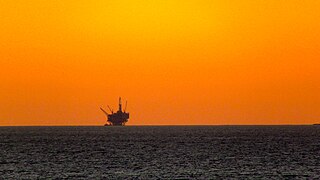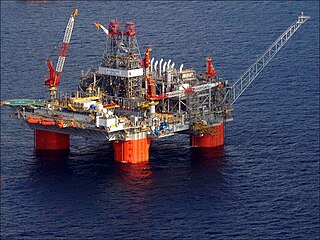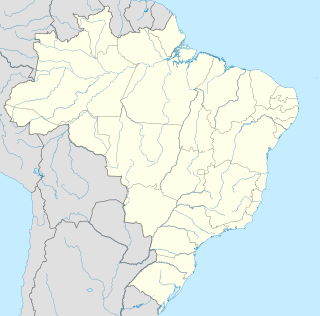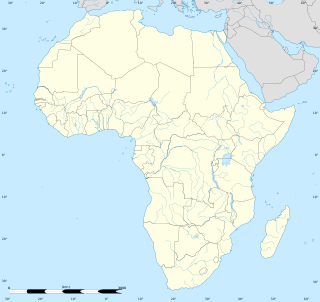This article needs to be updated.(November 2010) |
The Kizomba deepwater project is an oil drilling project owned and operated by ExxonMobil off the coast of northern Angola. It is named after the Kizomba Angolan dance.
This article needs to be updated.(November 2010) |
The Kizomba deepwater project is an oil drilling project owned and operated by ExxonMobil off the coast of northern Angola. It is named after the Kizomba Angolan dance.
The Kizomba A project utilizes the Hungo and Chocalho oil fields, in the so-called Block 15 concession off the Angolan coast. The project consists of a TLP and an FPSO, which receives oil from the wells to be stored until transfer to tankers.
The Kizomba A FPSO (at the time of its construction the world's largest) has a storage capacity of 2.2 million barrels (350,000 m3). Built at a cost of over US$800 million by Hyundai Heavy Industries in Ulsan, Korea, it is operated by ExxonMobil. In 1,200 metres (3,900 ft) of water at Deepwater block 320 kilometres (200 statute miles; 170 nautical miles) offshore in the Atlantic Ocean from Angola, West Africa, it weighs 81,000 tonnes and is 285 metres (935 ft) long, 63 metres (207 ft) wide, and 32 metres (105 ft) high. [1]
Kizomba B is 8 km (5.0 mi) to the east of Kizomba A. ExxonMobil reported the startup phase in October 2005. [2]
The third phase, Kizomba C, was designed to develop 600 million barrels of oil from the Mondo, Saxi and Batuque fields in approximately 2,400 ft (730 m) of water. [3] It was launched in 2008 through 2 FPSOs respectively named Saxi/Batuque and Mondo with a 100,000 bpd production capacity. [4]

An oil platform, offshore platform, or offshore drilling rig is a large structure with facilities for well drilling to explore, extract, store, and process petroleum and natural gas which lies in rock formations beneath the seabed. Many oil platforms will also contain facilities to accommodate their workforce. Most commonly, oil platforms engage in activities on the continental shelf, though they can also be used in lakes, inshore waters and inland seas. Depending on the circumstances, the platform may be fixed to the ocean floor, may consist of an artificial island, or may float. Remote subsea wells may also be connected to a platform by flow lines and by umbilical connections. These sub-sea solutions may consist of one or more subsea wells, or of one or more manifold centres for multiple wells.

The Sakhalin-I project, a sister project to Sakhalin-II, is a consortium for production of oil and gas on Sakhalin Island and immediately offshore. It operates three fields in the Okhotsk Sea: Chayvo, Odoptu and Arkutun-Dagi.

A floating production storage and offloading (FPSO) unit is a floating vessel used by the offshore oil and gas industry for the production and processing of hydrocarbons, and for the storage of oil. A FPSO vessel is designed to receive hydrocarbons produced by itself or from nearby platforms or subsea template, process them, and store oil until it can be offloaded onto a tanker or, less frequently, transported through a pipeline. FPSOs are preferred in frontier offshore regions as they are easy to install, and do not require a local pipeline infrastructure to export oil. FPSOs can be a conversion of an oil tanker or can be a vessel built specially for the application. A vessel used only to store oil is referred to as a floating storage and offloading (FSO) vessel.

Thunder Horse oil field is a large offshore deepwater oil field in the Gulf of Mexico, around 150 miles (240 km) southeast of New Orleans, Louisiana. Large new oil discoveries within it were announced in early 2019.
The Bonga Field is an oilfield in Nigeria. It was located in License block OPL 212 off the Nigerian coast, which was renamed OML 118 in February 2000. The field covers approximately 60 km2 in an average water depth of 1,000 metres (3,300 ft). The field was discovered in 1996, with government approval for its development given in 2002. The field began first production in November 2005. The field is worked via an FPSO vessel. The field produces both petroleum and natural gas; the petroleum is offloaded to tankers while the gas is piped back to Nigeria where it is exported via an LNG plant. The field contains approximately 6,000 mm barrels of oil.
Mobil Producing Nigeria (MPN) is one of three Nigerian subsidiaries of the petroleum company ExxonMobil. It began operations in 1955. All of its operations are offshore, where it owns 90 platforms on 3,200 square kilometres of territory. MPN is the second largest producer of crude oil in Nigeria after Shell. Erha field/vessel is the recent offshore deployment of ExxonMobil FPSO in Nigeria partnering with Nigerian National Petroleum Corporation.
The Dalia Oil Field is an oil field in deepwater block 17, 135 kilometres (84 mi) off the coast of Cabinda, Angola. The field lies in water depths varying between 1,200 and 1,500 metres. Dalia oil field was discovered in September 1997 and brought into production in December 2006.

The Schiehallion oilfield is a deepwater offshore oilfield approximately 175 kilometres (110 mi) west of the Shetland Islands in the North Atlantic Ocean. The Schiehallion and adjacent Loyal field were jointly developed by BP on behalf of the Schiehallion field partners; BP, Shell, Amerada Hess, Murphy Oil, Statoil and OMV, and the Loyal field partners; BP and Shell.

Foinaven oil field is deepwater oil development approximately 190 kilometres (120 mi) west of the Shetland Islands. Together with Schiehallion, Loyal, Solan, Clair and Lancaster fields it forms the area generally termed as the West of Shetland.
This page summarizes projects that brought more than 20,000 barrels per day (3,200 m3/d) of new liquid fuel capacity to market with the first production of fuel beginning in 2003. This is part of the Wikipedia summary of Oil Megaprojects—see that page for further details. 2003 saw 30 projects come on stream with an aggregate capacity of 2.499 million barrels per day (397,300 m3/d) when full production was reached.
This page summarizes projects that brought more than 20,000 barrels per day (3,200 m3/d) of new liquid fuel capacity to market with the first production of fuel beginning in 2006. This is part of the Wikipedia summary of Oil Megaprojects. 2006 saw 30 projects come on stream with an aggregate capacity of 4.092 million barrels per day (650,600 m3/d) when full production was reached this list does not like include any of the enormous project developed in the United states which dwarf these by +-5000 BOE.
This page summarizes projects that brought more than 20,000 barrels per day (3,200 m3/d) of new liquid fuel capacity to market with the first production of fuel beginning in 2007. This is part of the Wikipedia summary of Oil Megaprojects.
This page summarizes projects that brought more than 20,000 barrels per day (3,200 m3/d) of new liquid fuel capacity to market with the first production of fuel beginning in 2008. This is part of the Wikipedia summary of Oil Megaprojects.
This page summarizes projects that propose to bring more than 20,000 barrels per day (3,200 m3/d) of new liquid fuel capacity to market, with the first production of fuel beginning in 2012. This is part of the Wikipedia summary of oil megaprojects.
The Pazflor oil development is an offshore oil development in Angola. It involves Perpetua, Hortensia and Zinia, and Acacia (Oligocene) oilfields, which were discovered between mid-2000 and early 2003.

The FPSO Noble Seillean was a dynamically positioned floating oil production, storage and offloading vessel.

Roncador oil field is a large oil and gas field located in the Campos Basin, 125 km (78 mi) off the coast of Brazil, northeast from Rio de Janeiro. It covers a 111 km2 (43 sq mi) area and reaches depths between 1,500 and 1,900 metres.

The Jubilee Oil Field is an oil field located off the coast of the Ghana's Western Region in the South Atlantic Ocean under the ownership of the National Petroleum Authority and the Ghana National Petroleum Corporation.
The Tuapse field is a large offshore oil field located in the Black Sea, roughly 11,000 square kilometres (4,300 sq mi) in size and between 1,000 and 2,000 metres underwater, containing between 2.2 and 7.2 billion barrels of oil.

The Tweneboa Enyenra Ntomme Oil Field is an oil field within Ghana's territorial waters and the country's second major oil field after the Jubilee Oil Field. It is popularly known as the TEN oil field, an acronym formed from the three drilling fields that it comprises. Coincidentally, the exploration for oil in the basin also started with ten pre-first oil wells.